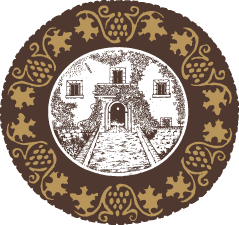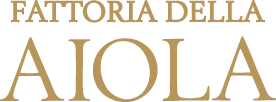The history
of Aiola
Walking in the vineyards of the Aiola estate, where centuries can be sipped like wine, it is hard to believe that these peaceful hills and groves had witnessed ferocious battles.
Threads of history
The earliest mentions of the fortress Aiola in the Historical Archive of Siena date back to the end of the XIV century. The city chronicles of the time, starting with a document from 1397, talk about Layola, Ajola or Ajole — calling it a fortress or a palace in need of military provisions: gunpowder and supplies. No wonder: at the time Siena and Florence were engaged in a bitter rivalry over power, wealth, influence, and territory. Aiola was the northernmost strongly fortified outpost of Siena, a place of great strategical and military importance. Yet almost nothing is known about its history and origins prior to 1397. Around mid-XV century the documents attest that the fortress of Aiola belongs to the noble family of Bellanti, one of the oldest and most famous patrician houses of Siena.
More than 800 years of history: from battles to barrels
On the branches of Bellanti’s genealogical tree, we can find astrologists and warriors, bishops and lawyers, saints, and sinners. They owned numerous palaces and estates in and around Siena, but Aiola was the crown jewel, a mighty fortress surrounded by vineyards. Some of the glorious and dramatic pages of Aiola’s history in the XVI century are linked to the name of Antonio Bellanti. Antonio was a typical Renaissance man — a warrior and a diplomat, a landlord, and a scholar. He was close friends with Aonio Paleario, a prominent humanist seeking to reform Catholicism, who spent several years in the Aiola, teaching a group of young nobles, including his friend and patron’s sons. Bellanti’s friendship had for some time protected Paleario from the Inquisition’s persecution, but after his patron’s death, as was the fate of many religious reformers of the time, Aonio Paleario was imprisoned and executed in 1570 for his "heretic views".
The Resistence
By mid-XVI century the fighting between Siena and Florence for dominance and territory became more and more fierce and bloody. Their conflict was part of the last chapter of Italian wars, where the Italian peninsula, divided into multiple states, became the battleground for European supremacy between France, Spain, England, and the Holy Roman Empire. In 1553 Cosimo de Medici, the ruler of Florence, moved his armies to finally capture Siena and establish his full control over Tuscany.
Only after a fierce and lengthy resistance offered by a small garrison and local peasants, Aiola is taken by the Florentime militia during the Italian Wars.
The mighty fortress of Aiola, Siena’s main strategic defence in the northern part, was a major obstacle in his way. The fortress had four towers and massive walls surrounded by a moat, crossed by a drawbridge. Gian Giacomo Medici, Marquess of Marignano, the leader of the Florentine forces, thought to easily overpower Aiola, manned at the time by only 25-strong garrison and local villagers.
But Aiola opposed such a fierce defence that Marignano was forced to bring an exceptionally large canon and two smaller ones from the nearby Radda. After more than 60 shots were fired, the Aiola walls were breached, but the garrison continued to fight bravely. A fatal shot from an arquebus had mortally wounded Medici’s favourite military engineer Giovanni Battista Belluzzi, known as San Marino.
But Aiola opposed such a fierce defence that Marignano was forced to bring an exceptionally large canon and two smaller ones from the nearby Radda. After more than 60 shots were fired, the Aiola walls were breached, but the garrison continued to fight bravely. A fatal shot from an arquebus had mortally wounded Medici’s favourite military engineer Giovanni Battista Belluzzi, known as San Marino.
Fiscal documents
We know little about the fate of Aiola between 1553 and 1692 — had the family of Bellanti managed to keep the castle or did they lose it as a result of the Medici conquest? But one thing we know for certain: the Aiola estate was alive: grain was grown, and wine was made. And this wine was taxed because nothing is certain but death and taxes, at least according to Benjamin Franklin. In 1692 we find mentions of Aiola fields, vineyards, their products, and taxes due and paid in the records of Uficcio delle Collette — the local fiscal office.
The first mentions of Aiola property in the taxpayers' lists of Ufficiali delle Collette
Sometime around the end of the XVIII century, the Aiola fortress underwent a radical transformation. Like many other defensive structures of medieval times, losing its military importance Aiola was gradually transformed into an elegant manor house while maintaining traces of the original defensive structure.
At the beginning of the XIX century, an artist and art historian Ettore Romagnoli traveled in Tuscany, visiting and sketching important mansions and monuments.
The imponent Aiola, a noble villa that retained the walls and fortifications of its glorious military past, has captured his attention. From Romagnoli’s sketch, we know how Aiola looked 200 years ago: mighty walls surround a palace with a portico.
You can still see remnants of corner towers and what looks like the remains of the massive central tower — probably the keep predating the XIV-XV century defensive structures.
At the beginning of the XIX century, an artist and art historian Ettore Romagnoli traveled in Tuscany, visiting and sketching important mansions and monuments.
The imponent Aiola, a noble villa that retained the walls and fortifications of its glorious military past, has captured his attention. From Romagnoli’s sketch, we know how Aiola looked 200 years ago: mighty walls surround a palace with a portico.
You can still see remnants of corner towers and what looks like the remains of the massive central tower — probably the keep predating the XIV-XV century defensive structures.
Fattoria della Aiola is born
At the beginning of the XX century, Aiola is a large agricultural estate. Unfortunately, on 13 September 1911 an earthquake with a magnitude of 5.1 shakes most of the Chianti territory. The majestic Aiola villa collapses, the two upper floors come down, only 10 of the pre-existing 39 rooms remain. A new owner, Erasmo Cavalier Devoto, restores Aiola, but its former splendour will not return until half a century later.
The brilliant future of the Chianti Classico’s Black Rooster
On 7 September 1935, the estate of Aiola becomes the property of Giovanni Malagodi. A prominent politician, and an innovative thinker, a member of the Italian Senate — hence his nickname, "il Senatore" - Giovanni Malagodi made Aiola Chianti Classico and other wines famous. Well ahead of his times "il Senatore" experimented with international grapes, like Cabernet Sauvignon and Merlot, blending them with Sangiovese and creating what would later be known as "Supertuscan" wines.
A forward-thinking and charismatic personality, Giovanni Malagodi made Aiola one of the first members of the recently born Consortium of Chianti Classico in 1947. He passionately believed in the brilliant future of the wine that became one of the symbols of Tuscany.
A forward-thinking and charismatic personality, Giovanni Malagodi made Aiola one of the first members of the recently born Consortium of Chianti Classico in 1947. He passionately believed in the brilliant future of the wine that became one of the symbols of Tuscany.
The new era begins
Some of the older vineyards are replanted with new, higher quality Sangiovese clones, less susceptible to illnesses and heat, while valuable older vines are taken good care of. New vineyards were planted as well, ensuring continuity and gradual expansion of production. The dominant grape is of course Sangiovese. Fattoria della Aiola carries on the tradition of growing autochthonous Tuscan varieties and selected international grapes that show a good fit to our terroir.
For us, 2012 is the year when a new page is opened in the history of Aiola
Combining tradition and the cutting edge of technology is our principle in everything: new fermentation tanks, a state-of-the-art wine press, a constantly expanding aging cellar ensure continuity of traditionally high quality and recognizable elegance of Aiola wines. Today Aiola wines are created by one of the best-known oenologists in Tuscany, Paolo Salvi, the student and follower of the great Giulio Gambelli, "the Sangiovese man". Paolo is a member of a truly international and diverse team of Aiola. The Aiola’s dedication and hard work are behind numerous international awards and high scores that our wines have garnered in the past few years, while "Cancello Rosso" has become the top quality tier of Chianti Classico DOCG — Gran Selezione.
Contact us
Office:
+39 0577 22615
info@aiolawines.com
Wine shop, Wine tasting booking:
+39 0577 322615
booking@aiolawines.com
+39 0577 22615
info@aiolawines.com
Wine shop, Wine tasting booking:
+39 0577 322615
booking@aiolawines.com
Click to order








